|
| More Toys...
|
|
| A (very) minimal list of items to begin
Reloading Straight-Walled Handgun cartridges.
I am making many assumptions to list the following items
to start learning how to reload...
a. 9mm is a common cartridge
b. be able to produce safe, good and usable cartridges
c. be able to acquire additional reloading equip,
as the interest and desire motivate
d. keep initial investment at a minimum
should this not be your next hobby
Get out the popcorn, it's Movie-Time...
A lot of folks have a new hobby "reloading video camera shooting",
They make a lot of Lighting, focus, sound, framing etc
errors in their video... rest assured they are just as
much of a novice with their "reloading" as with their video camera...
but, you get to see the equipment "in action".
A user has posted a 3-part video on YouTube that uses
fairly basic/minimal tools
to demonstrate reloading 9mm:
P1
P2
P3
Free Targets, for:
Pistol
&
Rifle
|
| |
|

|
Pistol-Powder: Hodgdon HP-38
$25 per pound / A very common reloading Pistol-Powder,
burns clean and reasonably "fast burning".
The powder "load" for handguns run approx 5.0gr,
at 7000gr per pound, easily provides over 1000 loads
Best purchased locally, as "hazard material" shipping fees
would apply.
Futhermore, Powder & Primers cannot ship in the same box,
so the Hazard-fees apply to each !!
Hodgdon's webpage for:
Pistol Powders, scroll down for HP-38
HP38 is a spherical powder that is great for low velocity
and mid-range target loads in the .38spec, 9mm, .44spec, and .45acp.
This high energy powder provides economy in loading.
Hodgdon provides an online
Basic Data Manual.
|
|
| Since powder is not sold in containers smaller than One-Pound,
and it provides enough powder for over 1000 "loads",
it only makes sense to get 1000 primers...
|

|
Primers: CCI #500 - Small Pistol
$40 per 1000 / A very common reloading primer for
'small pistol' cartridges.
Primers come in FOUR sizes, be sure to get standard "Small Pistol" primers.
Not: 'Magnum' or 'BenchRest' or LargePistol, LargeRifle or SmallRifle.
They are all different and cannot be substituted.
Other brands exist, too: Remington, Federal, TulAmmo,
Wolf and Winchester...
Best purchased locally, as "hazard material" shipping fees
would apply.
Futhermore, Powder & Primers cannot ship in the same box,
so the Hazard-fees apply to each !!
CCI's webpage for:
Standard Pistol Primers
|
|
| Now that we have Powder and Primers for 1000 reloads,
let's get 1000 bullets...
|
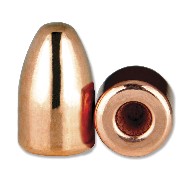
| BerrysMfg Bullets:
9mm HBRN-TP 115gr - CopperWash
$95 for 1000ct (product item #00173)/
A good bullet to begin reloading.
Another source of bullets & Lee Reloading stuff is
Titan, $15 for 100ct, referenced below.
|
|
|
The above items are 'consumable components', in this example,
about $160 per 1000 cartridges reloaded.
Keep a "lab notebook" of your components (date, $$, Lot##, etc)
and what "load" data you use.
This permits you to repeat the ones that work and
avoid the ones that don't.
|
|
|
Next are the One-Time purchase 'reloading tools'.
|
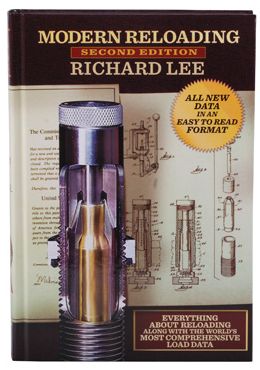
|
Book:
Richard Lee - Modern Reloading, 2nd
$18 / one of the best "load manuals", first ~125pages are a thorough
explanation of chamber-ballistics and reloading-processes/techniques
and the tools to perform it with more "load data"
than you can shake a stick at...
Lee's webpage for:
Modern Reloading book
Best to confirm "load data" online these days, like:
Hodgdon
|
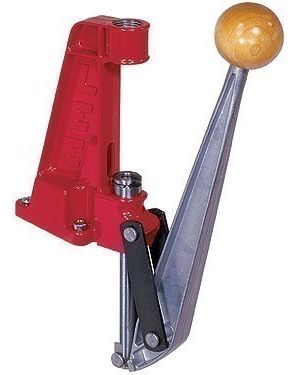
|
Lee Reloading Press
$28 / an adequate Press for straight-walled pistol brass.
NOT adequate for Rifle brass "sizing".
it needs to be mounted on a small board
(alongside the Powder-Dispenser),
which would be C-clamped to the workbench.
Lee's webpage for:
the Reloader Press
|
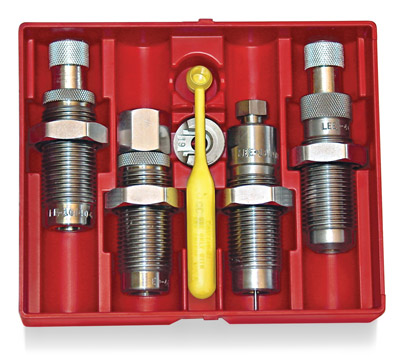
|
Lee Carbide 4xDie Set
$43 / A good handgun die set.
Dies: FL-Size, Flare/Powder, Seating, Crimp.
Plus shell-holder for the Ram/Press.
The use of each of these dies (and the RamPrime mentioned below)
will need particular "adjustment" in the press for the
particular caliber, brass and bullet in order to produce
the desired finished cartridge.
You would need another DieSet (~$45) for each Rifle/Pistol
caliber you wanted to reload.
Lee's webpage for:
Pistol 4xDie Sets
|
| Step: 1
Step: 2
Step: 3
Step: 4
Step: 5
| After (1) washing and drying the brass to remove dust, dirt,
grime and crud...
It should be run thru the Sizing-Die to
(2) remove the spent primer and
(3) re-size the brass to the specified diameter.
Clean the crud out of the primer-pocket with a small
flat-bit screwdriver.
The brass is now ready to use the Expander-Flair Die.
This die produces a sleight bell or (4) flairing
to the mouth of the case
in order to allow the bullet to seat evenly.
Once flaired, a (5) new primer can be inserted.
|

|
Lee RamPrime
$11 / This RamPrime gizmo attaches to the press where a die would
be placed. You handle each primer with your finger tips
to get the primer inserted into the Primer-Pocket.
You may soon find that you would prefer using the
Lee Ergo Primer Tool ($28).
You will need a
Primer-shellholder ($3) to hold your brass while the
primer is inserted.
This uses a different-shaped shell-holder from the Ram/Press
shell-holder provided with the Die set.
|
|
| Once the case is flaired and primed, the powder "load"
can be added. Handgun loads are in the range of about 5.0gr
per cartridge. A deviation of some 10% of the specified "load"
is expected to produce a "light" or "heavy" firing, more than
10% deviation can produce un-desirable results (stuck bullet
in the barrel... or too-much stress on the firearm!
|
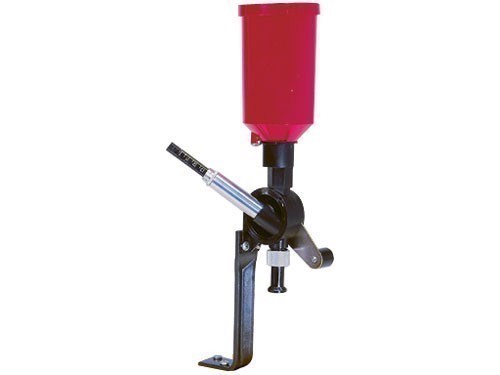
|
Lee Powder Dispenser
$25 / a basic (but good) powder dispenser.
once calibrated for a particular powder "load",
it will dispense the powder into each prepared case.
it needs to be mounted on a small board (alongside the Press),
which would be C-clamped to the workbench.
Lee's webpage for:
Powder Dispensers
|
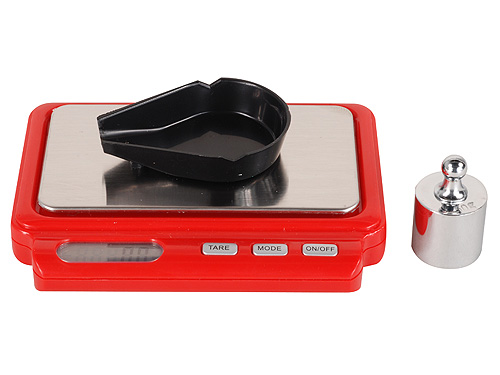
|
MtM mini Digital Scale
$40 / powder scales need to measure in 0.1gr resolution.
This digi-scale is extremely 'smart', check out the details
or "get one to see what's inside" (to paraphrase Nancy).
The powder-dispenser must be "calibrated" (adjusted/checked)
to dispense the "exact" amount of powder desired for a "load".
MtM's webpage for the:
DS-750 digital scale
A video on the MtM
DS-750 digital scale
| Step: 6
Step: 7
Step: 8
| Once the Powder-dispenser is calibrated for the desired "load",
drop the powder into five of the cases, visually inspect each
case to insure that they have a proper/equal amount of powder.
With the (6) Seating-Die, a bullet can be pressed into the
brass case to the proper depth.
Almost done.
The (7) Crimp-Die is used as a final step to place
a modest crimp of the brass case onto the bullet.
This insures a good seal of the cartridge for proper
initial pressure as the powder burns. It also helps to
hold the bullet in place when subjected to the
shock of ReCoil to prevent the bullet from moving
in/out of the case.
As a (8) "desk check", field strip your pistol and
remove the barrel.
Compare how easily a Store-bought-factory-cartridge
will slip in/out of the barrel chamber.
Does your reloaded cartridge do the same... ?
Observe very closely the depth at which the cartridge rests
in the chamber, is your ReLoad slightly higher/lower ?
if it is not really-close to the factory-ammo,
it may be poorly done and cause mis-feeds.
| |
|
The above items are adequate to reload perfectly usable cartridges.
I would consider this a 'starter set',
as other tools are desirable to insure easier/precise reloading.
However, to take the first-step
and be able to produce good cartridges this will do it.
If another handgun caliber is desired, just add $50
for the 4xDieSet for each caliber:
.38, .44, .45, ... etc.
Again, above is for Straight-walled Pistol cartridge reloading.
Rifle reloading presents additional equipment
and handling considerations.
| | |
| |
|
If my quick-math is close...
$160 for 1000-round consumables
$150 for basic tools
How much would 1000 rounds of your ammo cost ?
... and you still have the tools !!
the next 1000 reloads will cost $160
| | |
| |
| many more accessories and tools exist, depending upon the
desires and problems encountered.
As a beginning Reloader, seriously consider using
Remington™ ammunition and saving the brass for reloading.
Remington brass alloy resizes easily and has a well-formed
primer-pocket that makes cleaning and insertion of the new
primer a breeze, while many other brands present some
minor/frustrating obstacles.
Do not proceed to place an order for any of this equipment
just because it is listed here.
There are MANY aspects to to be discussed/described that
are too voluminous to type in a few words...
Alternate equipment choices exist, too.
Use this list as a 'discussion' check-list.
Click on the links (item description) to view the
product pricing, avail, detail description
with Feedback/Reviews ... at
MidwayUSA.com
All Lee products and some component-bullets can be
purchased via
Titan Reloading, in WI.
Good luck
and try not to become the next nominee for a 'Darwin Award'...
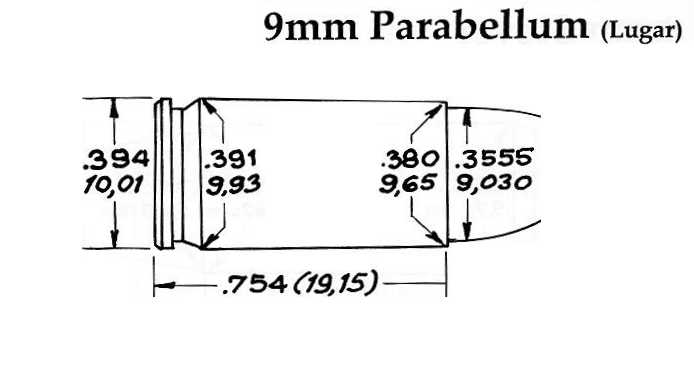
(paraphrased from the Lee 9mm die-set instructions)
1. Prepare Your Cases
Discard cases with defects such as split necks, indications of
head separation or anything that would make them unsuitable for
reloading. If you do not have the carbide sizer, this is a
good time to lube your cases. Use lube very sparingly.
2. Full Length Sizer
Screw the full length sizer in until it touches the shell holder
and tighten the lock ring finger tight. The decapper is retained
by a collet. Should it be overstressed by an obstruction;
it simply slides up without damage.
3. Expander Die
Screw the die in until it touches the shell holder,
back out one turn. Finger tighten the lock ring.
Screw the die in until flare is to your liking.
For maximum case life, flare only enough to easily
accept a bullet. In use, the expander plug travels approximately
3/8" wighin the die and comes to an abrupt stop
at extraction. This helps the[sic] shake the powder through.
However, we recommend you check to be sure all the powder has
cleared the funnel and expander plug.
Be sure to occasionally clean the bullet lube from the
expander plug to prevent a powder clog.
4. Charge the Case
Select a load from the chart.
This is the most criticxal decision you must make.
An overcharge can blow up nthe gun and injure the shooter
or persons nearby. It is dangerous to use a bullet of a
greater weight with a charge for a lighter bullet.
Never select a load intended for a bullet lighter
than you are using.
Loads for a slightly heavier bullet are safe.
Always start with the Starting Loads.
You maay work up to the Never Exceed Loads gradually,
provided you know how to watch for pressure signs.
a couple examples from the load sheet:
HP-38 Hogdgon Pistol Powder
9mm 115gr Jacketed Bullet
Start: 4.7gr 1081fps
Do Not Exceed: 5.1gr 1167fps
9mm 124gr Jacketed Bullet
Start: 4.4gr 1008fps
Do Not Exceed: 4.8gr 1088fps
5. Bullet Seating Die
Raise the ram to the top of its stroke and hold.
Screw the bullet seating die in until it touches the shell holder.
Then back it out three full turns.
Lightly finger tighten the lock ring.
Bullet depth is adjusted by screwing the adjusting screw in
or out to suit.
Bullets should be seated deep enough to work thru the guns action.
See Maximum Overall Length on the charge table.
6. Factory Crimp Die
The Lee Carbide Factory Crimper will not seat the bullet.
The bullet should be seated with a regulat bullet seating die,
but not crimped (some seating dies can be adjusted to place
a crimp as the bullet is seated).
Bullets should normally be seated so the crimp groove (cannelure)
is mostly inside the case mouth.
Screw the die in until it just touches teh shell holder and back
out the adjusting screw. Finger tighten the lock ring.
Always remove the die by turning on the lock ring to loosen.
With the loaded round in the die, turn the adjusting screw in
until you can feel it just touch the case mouth.
Then move the cartridge out of the die slightly and screw the
adjusting screw in 1/2 turn for a light crimp and
one full turn for a heavy crimp.
Some flaring dies can be adjusted to provide too much flare
and the case will not enter the crimp die. Try using the
sizing die to close the flare.
The carbide ring will size the brass when entering and upon
exit of the die. This assures that every case will freely
chamber in any standard firearm.
Do not expect the carbide sizer to touch every case,
it is a fail safe for the occasional bad round.
| | |
| |









